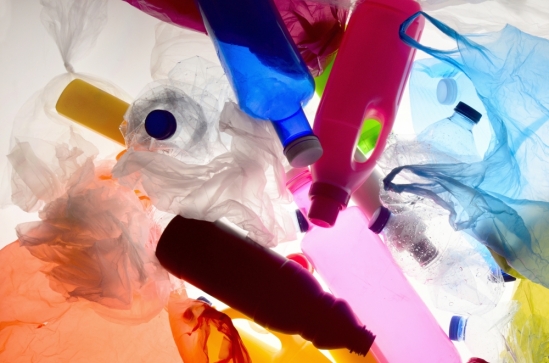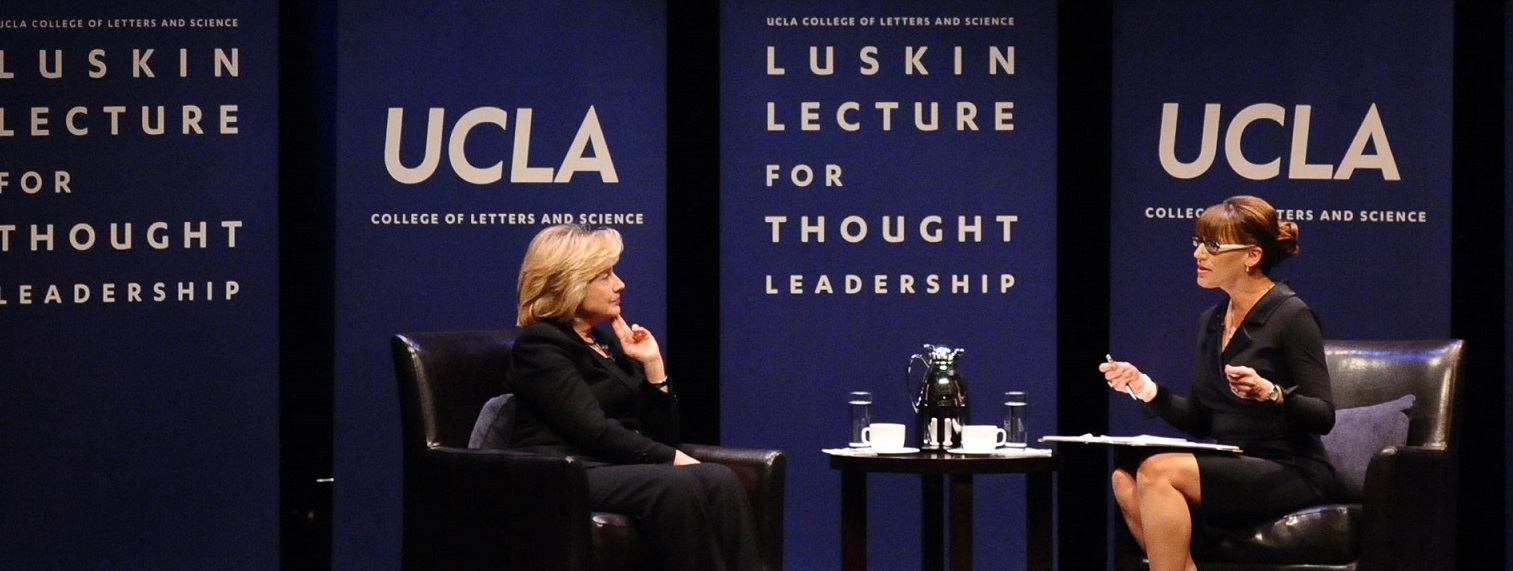
When we started using plastics about 70 years ago, not much thought — if any — was given to the implications of their lifespan and the fact that they can take centuries to decompose. Consequently, as plastics have diversified and become easier to manufacture, the planet is now straddling some 8.3 billion tons of the stuff — almost every bit of plastic ever produced — without enough technology or incentives to shrink that growing pile. Plastic is cheaper and easier to produce and throw away than it is to recycle.
大约70年前,当我们开始使用塑料的时候,没有多少人考虑过,也许有,塑料的使用寿命以及它们需要几个世纪才能分解的事实。因此,随着塑料的多样化和日趋容易的制造方式,地球上现在有83亿吨的塑料,几乎是生产过的所有塑料,没有足够的技术或激励来缩小这一不断增长的堆积。与回收相比,塑料的生产和丢弃更便宜,也更容易。
UC Santa Barbara researchers Susannah Scott and Mahdi Abu-Omar are poised to shift this decades-old paradigm.
加州大学圣巴巴拉分校的研究人员苏珊娜·斯科特和马赫迪·阿布-奥马尔准备改变这一已有几十年历史的模式。
How? With a one-pot, low-temperature catalytic method that upcycles polyethylene — a polymer that is found in about a third of all plastics produced, with a global value of about $200 billion annually — into high-value alkylaromatic molecules that are the basis of many industrial chemicals and consumer products. Adding value to what would otherwise become trash could make plastic waste recycling a more attractive and practical pursuit with an environmentally beneficial outcome.
如何进行呢?采用单锅低温催化方法对聚乙烯进行循环,将聚乙烯(一种聚合物,存在于大约三分之一的塑料中,每年全球价值约2000亿美元)升级为高价值的烷基分子,它是许多工业化学品和消费产品的基础。给原本会变成垃圾的东西增加价值,可以使塑料废物的回收利用成为一项更有吸引力和更实际的追求,并产生有利于环境的结果。
“Here’s a potential solution,” said Scott, who with her colleagues has now published their research in the journal Science. Their effort, she said, is one in a growing list of possible measures that can be taken to turn plastic’s linear, wasteful economy into a more sustainable, circular one.
“这是一个可解决方案,”斯科特说,她和她的同事已经在《科学》杂志上发表了她们的研究。她说,她们的努力只是越来越多可能采取的措施之一,这些措施可以把塑料的线性、浪费经济转变为更可持续的、循环的经济。
“This is a demonstration of what can be done,” she said.
“这证明了我们可以(对废弃塑料)做些什么,”她说。
Closing the loop on plastic waste
打破塑料只能是垃圾的事实
There’s no denying that modern existence owes a lot to plastics, from the packaging that keeps foods fresh, to the sterile materials used in medical applications, to the cheap, lightweight parts that go into many of our affordable, durable goods.
不可否认,现代社会的便利在很大程度上要归功于塑料,从保持食品新鲜的包装,到医疗应用中使用的无菌材料,再到许多我们负担得起的耐用商品中使用的廉价、轻便的部件。
“There are many positive things about plastics that we have to keep in view,” said Scott, a professor of chemistry and of chemical engineering at UC Santa Barbara, who holds the UCSB Mellichamp Chair in Sustainable Catalytic Processing. “At the same time, we realize that there is this really serious end-of-life issue which is an unintended consequence.”
斯科特是加州大学圣巴巴拉分校(UC Santa Barbara)的化学和化学工程教授,在UCSB Mellichamp可持续催化处理领域担任主席。他说:“关于塑料,我们有很多积极的方面需要关注。与此同时,我们也意识到一个非常严重的临终问题,这也许是个意想不到的后果。”
The property that makes plastics so useful is also what makes them so persistent, the researchers explained. It’s their chemical inertness — they generally don’t react to other components of their environment. Plastic pipes don’t rust or leach into the water supply, plastic bottles can store caustic chemicals, plastic coatings can resist high temperatures.
研究人员解释说,使塑料如此有用的特性来源于它们的持久性。这是它们的化学惰性。通常,它们不会对环境中的其他成分发生反应。塑料管不会生锈或渗入供水系统,塑料瓶可以储存腐蚀性化学品,塑料涂层可以抵抗高温。
“You can put one of these pipes in the ground and a hundred years later you can dig it up and it’s exactly the same pipe and it keeps your water completely safe,” Scott said.
斯科特说:“你可以把其中一根管道埋在地下,一百年后,你可以把它挖出来,它还是原来的管道,它可以保证你的水完全安全。”
But this quality of inertness also makes plastics very slow to break down naturally and very energy intensive to do so artificially.
但是惰性的特性也使得塑料的自然分解非常缓慢,而且人工分解需要耗费大量的能源。
“They’re made with carbon-carbon, and carbon-hydrogen bonds, and they’re very difficult to chemically recycle,” explained fellow chemistry and chemical engineering professor Abu-Omar, who specializes in energy catalysis and holds the UCSB Mellichamp Chair in Green Chemistry. Though much research effort has been spent on learning how to reduce plastics to their basic components for sustainability purposes, the energy cost “has plagued the field for a long time,” the researchers said. Even the benefit of converting these building blocks into high-value molecules is limited when it’s cheaper to do the same from extracted petroleum.
“它们是由碳-碳和碳-氢键组成的,很难进行化学循环,”研究人员、化学和化学工程教授阿布-奥马尔解释说,他专门研究能源催化,并在UCSB Mellichamp任Green Chemistry的主席。研究人员说,尽管人们花了很多精力研究如何将塑料减少到可持续性的基本成分,但能源成本“长期以来一直困扰着该领域”。即使是将这些构建块转化为高价值分子的好处也受到了限制,因为从石油中提取同样的物质成本更低。
“On the other hand, if we could directly convert the polymers to these higher-value molecules and completely cut out the high-energy step of going back to these building block molecules, then we have a high-value process with a low energy footprint,” Scott said.
“另一方面,如果我们可以直接将聚合物转化为这些高价值的分子,并完全省去了返回这些构建分子的高能量步骤,那么我们就拥有了一个低能耗的高价值过程,”斯科特说。
That innovative line of thinking produced a new tandem catalytic method that not only creates high-value alkylaromatic molecules directly from waste polyethylene plastic, it does so efficiently, at low cost and with a low energy requirement.
这一创新思路产生了一种新的串联催化方法,它不仅直接从废弃聚乙烯塑料中产生高价值的烷基化分子,而且效率高、成本低、能耗低。
“We brought the temperature of the transformation down by hundreds of degrees,” Scott said. Conventional methods, according to the paper, require temperatures between 500 and 1000°C to break down the polyolefin chains into small pieces and reassemble them into a mixture product of gas, liquid and coke, while the optimal temperature for this catalytic process hovers in the neighborhood of 300°C. The relatively mild reaction condition helps break down polymers in a more selective way to a majority of larger molecules within a lubricant range, the researchers explained. “And, we simplified the number of steps in the process because we’re not doing multiple transformations,” Scott said.
“我们把转变的温度降低了数百度,”斯科特说。根据这篇论文,传统的方法需要500 - 1000℃的温度才能将聚烯烃链分解成小块,并重新组装成气体、液体和焦炭的混合物,而这种催化过程的最佳温度在300℃左右。研究人员解释说,相对温和的反应条件有助于以一种更有选择性的方式分解聚合物,使其在润滑油范围内形成大多数大分子。“而且,我们简化了这个过程的步骤,因为我们没有做多重转换,”斯科特说。
In addition, the process requires no solvent or added hydrogen, just a platinum on alumina (Pt/Al2O3) catalyst for a tandem reaction that both breaks those tough carbon-carbon bonds, and rearranges the polymer’s molecular “skeleton” to form structures with those characteristic six-sided rings — high-value alkylaromatic molecules that find widespread use in solvents, paints, lubricants, detergents, pharmaceuticals and many other industrial and consumer products.
此外,流程不需要溶剂或添加氢,只是一个铂在氧化铝(Pt /氧化铝)串联反应的催化剂,打破那些艰难的碳碳键,并将聚合物的分子“骨架”的形式结构与特征六面环-高附加值alkylaromatic分子中找到广泛使用溶剂、油漆、润滑剂、清洁剂、制药和其他许多工业和消费产品。
“Forming aromatic molecules from small hydrocarbons is difficult,” added the paper’s lead author, postdoctoral researcher Fan Zhang. “Here, during aromatics formation from polyolefins, hydrogen is formed as a byproduct and further used to cut the polymer chains to make the whole process favorable. As a result, we get long-chain alkylaromatics, and that’s the fascinating outcome.”
“从小碳氢化合物中形成芳香族分子是困难的,”该论文的第一作者、博士后研究员张帆补充道。“这里,在聚烯烃形成芳烃的过程中,氢作为副产品被形成,并进一步被用来切断聚合物链,使整个过程更有利。结果,我们得到了长链烷基化学,这是令人着迷的结果。”
This method represents a new direction in the lifecycle of plastics, one in which waste polymers could become valuable raw materials instead of winding up in landfills, or worse, in waterways and other sensitive habitats.
这种方法代表了塑料生命周期的一个新方向,在这个方向中,废弃的聚合物可以成为有价值的原材料,而不是在垃圾填埋场,或者更糟的是,在水道和其他敏感的栖息地。
“This is an example of having a second use, where we could make these raw materials more efficiently and with better environmental impact than making them from petroleum,” Abu-Omar said. Research must still be conducted to see where and how this technology would be most effective, but it’s one strategy that could help mitigate the accumulation of plastic waste, recoup their value and perhaps reduce our dependency on the petroleum that plastics come from.
阿布-奥马尔说:“这是二次利用的一个例子,与从石油中提取相比,我们可以更有效地利用这些原材料,对环境产生更好的影响。”我们还必须进行研究,看看在哪里以及如何使用这种技术会最有效,但这是一种策略,可以帮助减少塑料垃圾的积累,回收它们的价值,或许还可以减少我们对塑料来源石油的依赖。
“We dig a hole in the ground, we produce, we make, we use, we throw away,” Abu-Omar said. “So in a way, this is really breaking that way of thinking. There’s interesting science to be done here that will lead us into new discoveries, new paradigms and new ways of doing chemistry.”
阿布-奥马尔说:“我们在地上挖个洞,生产、制造、使用、扔掉。”所以在某种程度上,这确实打破了那种思维方式。这里有很多有趣的科学可以研究,这些科学将引领我们探索化学的新发现、新范式和新方法。”




